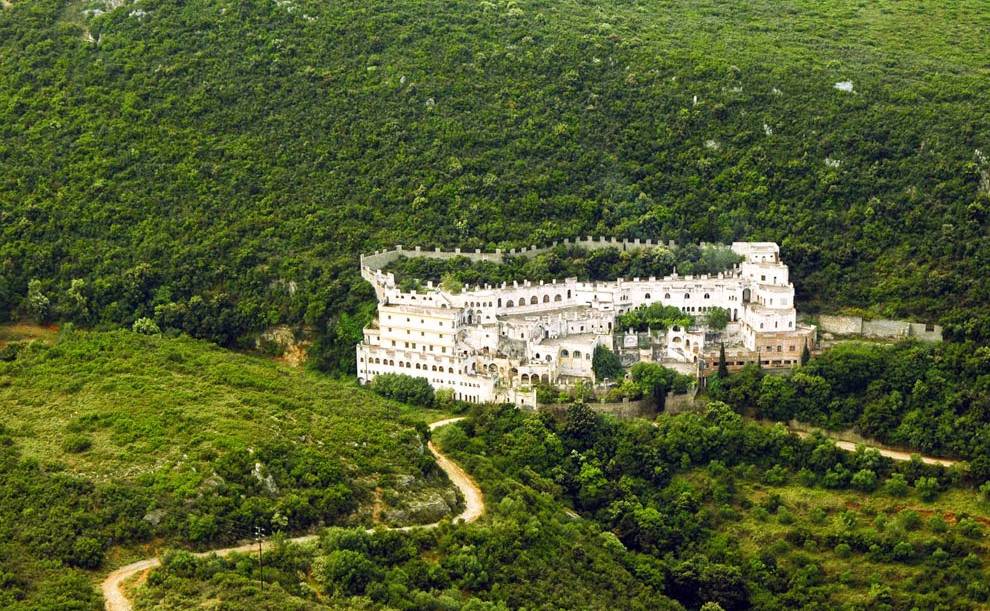The "Ascetic's" monastery - The Babel of the Peloponnese
In Gargaliani (64 km from Kalamata), in dense vegetation, the visitors can suddenly see in front of them a labyrinthine building complex, which unfortunately is now in ruins. It is the monastery of "Askitis", also known as "Askitario", a monastery that never operated. Its unusual multi-storey architectural structure, with its hundreds of small rooms, makes it look like an intricate maze.
According to theologian Panagiotis Gliatas, the history of "Askitario" began in 1887. The then 27-year-old Athanasios Stragas, from the village of Soulos in Megalopolis, fell ill with tuberculosis. Having the unfulfilled desire of the ascetic life from an early age, he went to stay in a small cave at the place called "Karantina (Quarantine)" close to Gargaliani. When he overcame his illness, he continued to work as a labourer in the local estates. In time he raised money and bought a piece of land. At the same time, he dug deeper and deeper into the cave where he lived with the prospect of building a temple dedicated to the Holy Trinity. He built two more small rooms, a storeroom and a cistern to have drinking water. The years passed, the five children he had left behind in the village grew up and Athanasios even had grandchildren. In fact, in 1933, one of his grandchildren was ordained a clergyman while being single. He was the later archimandrite Theoklitos Stragas, who, during his service as a clergyman, held important positions in the Ecclesiastical administration (Secretary of the Holy Synod, Protosyncle of Metropoles, etc.). Theoklitos Stragas was very well acquainted with the pastor of Panagia of Gargaliani, Papa-Giannis Stavrianopoulos.
In 1936, the now old ascetic, returning from Gargalianι to his cave, slipped on a slope and hit severely. As the days went by, his condition worsened and on March 14th, 1937, Athanasios Stragas passed away. He was buried in his favourite hermitage by Papas (Priest) John, in a tomb he had carved on the rock. After his death, the place was deserted as none of his heirs wanted to live in the area.
On January 15th, 1950, in the "Simaia" newspaper of Kalamata, an article by Sotiris Lyrintzis was published under the title: "An Ascetic". The journalist presented "Barba-Thanasis" as a pious and very likeable man, as we read in the following excerpt: Fifty years ago, old Barba (Old man) - Thanasis used to live by money earned from his daily work. However, no matter how poor the external appearance of this man was, so rich and kind and pulsating was the emotional wealth inside him ... "
The article mentioned above was the occasion for the archimandrite (and his grandson), Theoklitos Stragas, to show interest in the "Hermitage". So, he printed a small book with the life of the ascetic, recovered his remains (in the presence of a large crowd), and decided to start the renovation-reconstruction of the "Hermitage". The reconstruction work finally began in 1968 and most of the work was completed ten years later. The architect and contractor was the archimandrite himself. Then, Theoklitos started the actions in order to give legal status to the "Hermitage". Thus, the heirs of the ascetic, namely the archimandrite Theoklitos Stragas, Efstathia Gouma and Theodora Karali, submitted to the metropolitan of Trifylia and Olympia, Stefanos, a document requesting the recognition of the "Hermitage" as an institution with the Hermitage of Gargaliani, The Holy Trinity ". The purpose of the establishment of this foundation was: "... to house in the five independent houses donated by its founders, people who wish and can imitate the Saint Athanasios Stragan's fifty-year-old cave hermitage ..." A basic condition for these people were not to become monks, but as laypeople to live a solitary life, like ascetic Athanasios. Metropolitan Stefanos sent the document to the Holy Synod, which: "... rejected the establishment of this institution as a foreign to the Monastic Law of the Eastern Orthodox Church". After the refusal of recognition in this form, the heirs requested the revocation of the founding act from the First Instance Court of Kyparissia.
In 1982, Theoklitos wrote a letter asking the metropolitan to recognise the place as a "Holy Pilgrimage". Thus, three years later, in 1985, the Provisional Administrative Regulations for the "Holy Trinity Pilgrimage to the Holy Trinity of the Gargaliani Hermitage" were published in the "Government Gazette", as well as in the magazine "Church", which, among other things, provided for the drafting Rules of Procedure by the Administrative Committee after the Establishment of the Church and the inauguration of the Foundation. In the end, the Holy Pilgrimage was never inaugurated by the Diocese because those involved were never found in agreement with the Rules of Procedure.
In 2008, the shooting of the film "The Horsemen of Pylos" by Nikos Kalogeropoulos, starring himself and Takis Spyridakis, took place in the building complex of "Askitari". In fact, Nikos Kalogeropoulos gave the ruined labyrinth the apt designation "Polypylo". Finally, since 2008 the space has been owned by the Konstantakopoulos family, owners of the luxury hotel, Costa Navarino, in Pylos.








